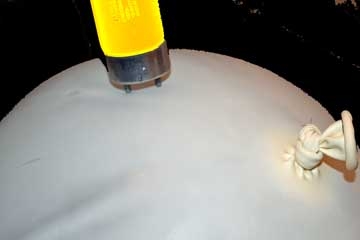
What you need:
A balloon
A fluorescent lamp or fluorescent the light
What to do:
1. Inflate the balloon and knot in mouth closed
2. Dim the lights of the room.
3. Rub the inflated balloon vigorously over your hair or on a woollen sweater
4 Touch the balloon to the two metal electrodes at the end of the tube
What happens:
When the balloon is touching the metal prongs, the tube lights up for a few moments.
Why?
This happens due to static electricity. Static means stationary. When you rub two objects against each other (like the balloon and your hair), they develop stationary electrical charges .To understand why this happens. We have to go to the microscopic level. Everything in our world is made up of tiny particles called ‘atoms.
These atoms are, in turn, made up of even smaller particles known as electrons, protons and neutrons. The protons and neutrons remain inside the atom but the electrons like to use any excuse to jump in and out of the atom. When you rub two objects together, the electrons from one object jump to the other. This exchange of electrons is what is termed as electrical charge.
When the balloon is rubbed over hair, electrons jump from our hair to the balloon and stay there.
A fluorescent tube light is usually coated on the inside with a white material (known as a phosphor) and is filled with mercury gas.
When you plug in the fluorescent tube, an electric current is passed through it. Electricity is nothing but the movement of electrons. These electrons dash through the mercury gas, causing it to emit ultraviolet light.
Ultraviolet light is able to the human. That’s where the phosphor coating comes in. This coating absorbs ultraviolet light and releases visible light instead.
When you hold the charged balloon dose to the metal prongs of the light the electrons jump from the balloon to the tube (since metal is a good conductor), causing it to light up. This light remains until all the electrons at the point of contact (where the balloon meets the prongs) are used up.
Picture Credit : Google




